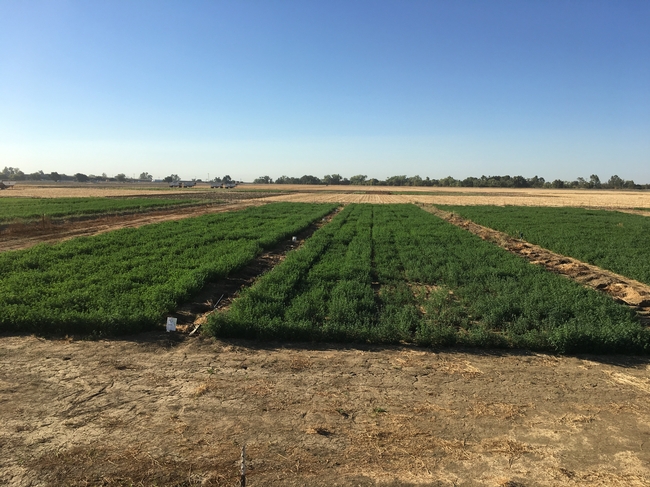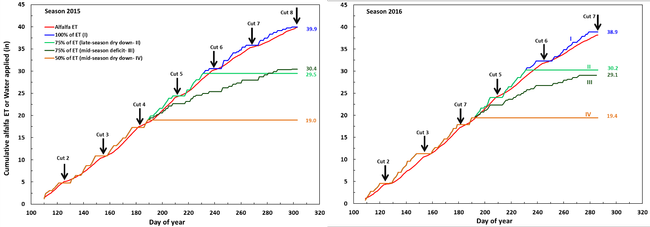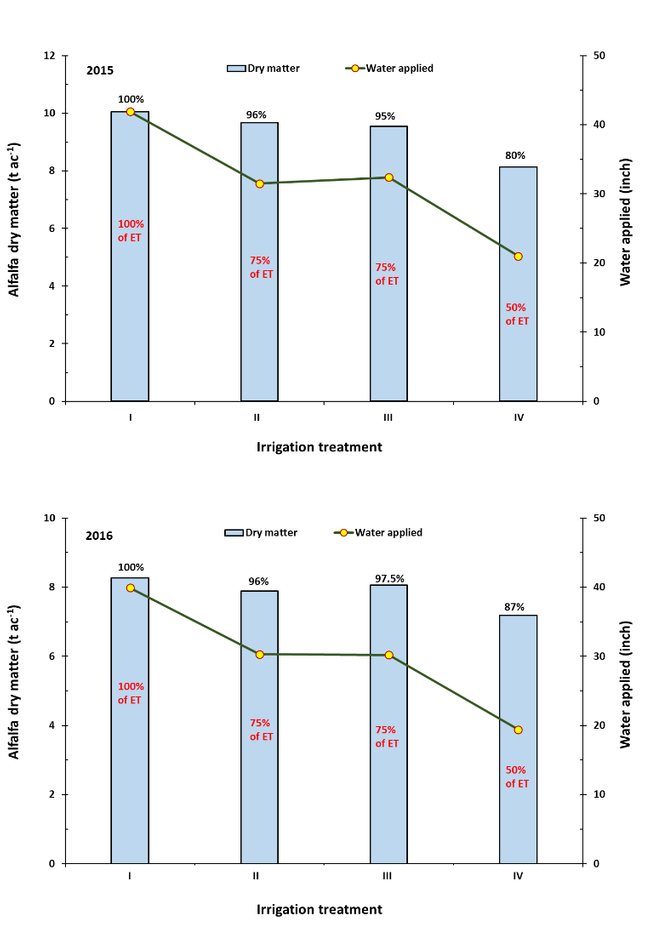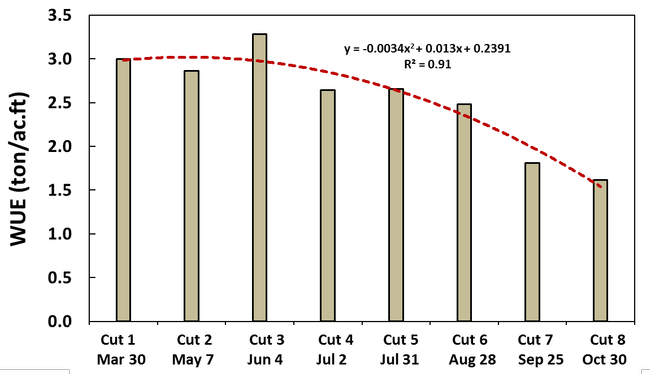By Daniel H Putnam
OK, it's January and raining outside. So we can forget about water issues, right?
Farmers know better. Water planners know better. Snow pack is only a fraction of normal as of today, and most of the south state is still under ‘exceptional drought'.
Given the large urban, ag., and environmental demands……we know that demand is likely to exceed supply for many years into the future.
So how does agriculture cope with these realities? University of California scientists and the farming community have been working on methods to cope with periodic agricultural water shortages for the future, and taking a long-term view. See UC Drought Tips at: http://ciwr.ucanr.edu/california_drought_expertise/droughttips/
WATER STRATEGIES FOR ALFALFA
Alfalfa is California's #2 agricultural water user (almond has taken the #1 spot), and so is frequently a target of criticism, with some simply recommending to cease alfalfa production as a ‘solution' See Sacramento Bee October, 2016.
However the threats to the livelihood of thousands of farmers, a $1.4 billion hay industry, the nation's leading $7 billion dairy industry must be considered – after all, alfalfa produces food for the consumer (enjoy that pizza-find the alfalfa)! Besides, as has been stated in this space, alfalfa is actually the BEST crop to have in a drought (see blog). Alfalfa is among the highest in water use efficiency (WUE-DM yield per unit water) and offers more flexibility than many other crops during low water years.
The solutions for improving water management in alfalfa are many, including better methods of application (drip, advanced surface systems, and better sprinkler systems), better irrigation scheduling and management (matching applications with crop need), soil moisture monitoring, and improving yields and thereby WUE.

Figure 1. Water deficits were applied to 15 varieties this deficit trial at Davis, CA. Left is fully irrigated, right is deficit irrigated block with water cut-off in July. Photo, September, 2016.
DEFICIT IRRIGATION STRATEGIES
One solution is ‘deficit irrigation' – watering less than the seasonal EvapoTranspiration (ET) needs of the crop which has been the subject of research over the past decades.
Regulated deficit irrigation can be done in several ways, either ‘starvation diet' (incremental reductions in watering over the season) or ‘cold turkey' (sudden cut-offs of water mid-season following full early irrigation). Of these, we heavily favor the ‘cold turkey' approach, illustrated in this study.
Although scientists have worked on this concept for decades, recent data from UC Davis confirms the value of this strategy. Here we will share some of the preliminary data from this study.
2014-2016 Field experiments. Field trials were planted in 2014 on a deep productive silt-loam soil at Davis, CA under Subsurface Drip Irrigation (SDI, 40” spacing, 10-12” deep), and treatments applied 2015 and 2016. Fifteen commercial or newly-released alfalfa varieties were established under four irrigation regimes in a randomized complete block design with a split plot restriction with four replications. Each plot was 16×4 ft. Germination was achieved using sprinkler irrigation, and thereafter SDI irrigation was used.
The irrigation treatments were:
- I (full irrigation at 100% of crop ET utilizing ET-based irrigation scheduling)
- II (75% of seasonal crop ET; full irrigation until dry down mid-August)
- III (75% of seasonal crop ET; full irrigation until 50% of seasonal ET occurred on early July and then 50% sustained deficit irrigation for the rest of the season)
- IV (50% of seasonal crop ET; full irrigation until 50% of seasonal ET occurred on early July and then cutoff irrigation for the rest of the season).
The full alfalfa ET was determined by a nearby experiment in Davis using Eddy Covariance instruments – the daily crop coefficient (Kc) values were adjusted based upon the changes observed during each cutting schedule – with the summed Kc values totaled approximately 0.86 of reference ET (ETo) directly from our Eddy Covariance readings for the fully irrigated treatment, and deficits applied according to accumulated ETc.
Preliminary Results. The total alfalfa ET under full irrigation were 39.9 and 38.9 inches for the season 2015 and 2016, respectively (Figure 2). The cumulative applied water at the irrigation treatments II, III, and IV over the irrigation season 2015 were 29.5, 30.4, and 19.0 inches, respectively; and 30.2, 29.1, 19.4 inches for the irrigation season 2016, respectively. The total crop water requirements between planting to the last harvest of growing season 2015 was estimated 52 inches, and between the crop at January 15th 2016 and the last harvest of growing season 2016 was estimated 42 inches. The soil moisture sensors demonstrated that soil water balance at the early season of both years were very similar; and the irrigation season started with a soil full profile.

Figure 2. Cumulative alfalfa ET and water applied over the irrigation season of 2015 and 2016, UC Davis deficit irrigation trial.
Yields. Total dry matter yields (averaged over 15 alfalfa varieties) of 10.2 and 8.5ton ac-1 were observed at the fully irrigated treatment over the season 2015 and 2016, respectively (Figure 3). A 20% yield reduction for the first season and 13% for the season second were obtained for the 50% deficit irrigation scenario, mostly from the last four cuttings of the growing season, which were affected by severe water limitations.The slight yield reductions with the 75% ET treatments deficit irrigation regimes were very similar, averaging about 4%.
The reason of low yield penalty for the deficit irrigation strategies is the higher yield productivity of spring and early-summer cuttings compared with the remainder of harvests over growing season. A total of 74.1% of seasonal dry matter yield for the season 2015 and 70% for the season 2016 was obtained over the first five cuts until the end of July. This is a key attribute of alfalfa – the seasonality of yield distribution which enables late-season dry-downs with limited yield penalty. Additionally, the deep root system enables extraction of deep moisture to sustain late-season yields even after irrigation ceases.

Figure 3. Alfalfa dry matter yields and water applied for each irrigation treatment (season 2015 and 2016)
Water Use Efficiency. The averaged WUE (the ratio of dry matter yield to applied water) value averaged across all the 15 varieties with full irrigation was 2.6 ton/ac.ft, while the results indicate that alfalfa WUE can be significantly affected by deficit irrigation regimes (Table 1). Deficit irrigation effectively increased alfalfa WUE. For instance, a 53% increase of WUE (3.8 ton/ac.ft) was observed for the 50% deficit irrigation treatment.
Table 1. Values of water use efficiency obtained for the different irrigation treatments (season 2015)
Irrigation treatment | IR I | IR II | IR III | IR IV |
WUE (ton/ac.ft) | 2.6 | 3.3 | 3.2 | 3.8 |
Importance of SDI. Although deficit irrigation is feasible with all irrigation systems, a greater WUE may be achieved under SDI-irrigated alfalfa. This is due to the ability to more carefully control water applications compared to flood irrigation, and to match ET. Hanson et al. (2007) reported an alfalfa WUE of 1.7 and 1.2 ton/ac.ft under border irrigation in the San Joaquin Valley and Imperial Valley, respectively, for example.
Importance of Season. WUE declines significantly over the season, due to late-summer low yields even under full irrigation (Figure 4, 2015 data). Water applications remain high in July-August and September, while yields are limited, often due to what is called ‘summer slump' (physiological reductions in yields due to daylength and plant biology - see blog). No irrigation occurred over the first cycle up to the first cutting. As a result, and consequently the water use efficiency is greater in earlier cuttings than that of mid-summer and fall.

Figure 4. Alfalfa WUE values over the seasonal cuttings in full irrigation treatment (season 2015)
Stand Persistence. In addition to yield declines, the risk of stand damage could be a significant issue with deficit irrigation strategies. So far, in this trial, little stand decline has been observed due to 50% or 25% water deficits after two years at this location. Our experience with deficit trials in farmers fields show limited stand decline on many soils, with the exception of the harsh desert conditions of Imperial and Palo Verde
TENTATIVE CONCLUSIONS AND CAUTIONARY NOTES:
- Alfalfa has the ability to be deficit irrigated as illustrated by this two-year data set and numerous previous studies on this issue (see references below). In the past 4 years of drought, growers have in many cases stopped irrigation mid-season due to lack of water and obtained partial yields from residual moisture.
- In this study, water reductions of 50% resulted in 13-20% yield reductions over the two years, while water reductions of 25% compared resulted in less than 5% yield reductions. This illustrates the high flexibility of this crop in tolerating late-season deficits.
- Such limited yield losses occurred because late-season yields are low even with full irrigation, and early-season WUE is high.
- While deficit irrigation is feasible with all irrigation methods, SDI methods may have been important in reducing yield losses in this experiment since we were able to fully meet ET needs of the crop with this more flexible system. SDI may also enable small applications of water late in the year if stands appear threatened.
- Keep in mind that this study was done on Class I clay-loam soils. It is highly likely that different results would be expected on different soil types, especially in very sandy soils, soils with limited rooting depth, or under hot desert conditions.
- It is not known whether continuous deficit strategies are advisable year after year – there could be cumulative effects. In this study, little plant loss was seen, which has been the case in most of our previous on-farm studies with the exception of the Low Desert, where significant stand decline can occur with summer dry-downs.
- A key management issue is re-filling the profile at the beginning of the season. In this experiment, soil moisture was significantly depleted in the severe deficit treatment at the end of each year. In both years, we re-filled the profile to full capacity in the early spring, which sustains crop growth during the heat of the summer.
- Late-summer dry downs are likely to be better than ‘starvation diet' deficit treatments since yields are higher in the early part of the season, and avoiding late harvests may save harvesting, pest management and other costs.
- Salt management may be a limitation of deficit irrigation strategies – leaching for salt management may be needed.
- Economic models to understand the value of deficit irrigation strategies and yield/water trade-offs are needed.
While full irrigation is the goal for maximizing yields, this study supports many of the previous UC studies and grower experience that indicate alfalfa's ability to be deficit irrigated to deal with seasonal limitations of water supply. Management is key: when short on water we recommend fully filling the profile in the early part of the year for full production, and allowing late-season dry downs to conserve water when necessary. Sustaining vigorous forage production during periods of drought (or demands for economic water transfers) is important aspect of resiliency in agriculture to cope with ups and downs of water availability.
Source:ucanr.edu